Ethnicity estimates can vary between companies. They have different algorithms, different reference populations, and define different regions. To show you what Dutch DNA could look like with the various companies, here are my own results.
Based on my tree, I should be >99% Dutch, with a bit of German and French. I have some medieval lines from other countries in the 1200s and before, but the chances of me having inherited any of their DNA is minimal. My father’s side is from Gelderland, near the German border, and my mother’s from Noord-Brabant and Zeeland, near the Belgian border. So how did the companies do?
Companies fine-tune their predictions over time. This is the third article I’ve written about this. I left the previous ones online, so you can compare the current estimates to the ones in 2016 and 2018.
Ancestry
Ancestry thinks I’m 53% England, Wales & Northwestern Europe, 45% Germanic Europe, and 2% Swedish. The overview map shows the first category located in England and Wales, but if I click on that category, is shows a lighter area that includes the southern part of the Netherlands where my mother’s family is from. So although I find it weird for that part of the Netherlands to be lumped in with England and Wales, I can’t say it’s incorrect.
The Germanic European, which Ancestry thinks belongs to the genetic community Netherlands, is spot on. I don’t know where the 2% Swedish DNA came from, but that might be noise.
Interestingly, my mom has the same roughly 50/50 split between English/Wales/NW Europe and Germanic Europe, so it’s not like all of her DNA was responsible for one predicted ethnicity and my father’s ancestors on the German border were responsible for the other.
There is a big difference since 2018, when Ancestry had me as 94% Western European, and low confidence regions Great Britain (2%), Iberian Peninsula (2%), Ireland/Scotland/Wales (1%) and Scandinavia (<1%). The Iberian disappeared completely, but was marginal to begin with.
23andMe
23andMe predicts me to be 58.1% French & German, 22.9% British & Irish, 4.2% Scandinavian, 14.3% Broadly Northwestern European, 0.1% Broadly European, and detected trace ancestry of 0.3% Anatolian, 0.1% Broadly Central Asian, Northern Indian & Pakistani.
The French & German has gone up since 2018, which is good since according to my research that should be 100%.
If I click through to the regions for French & German, it identified Gelderland and Noord-Brabant as the top two positions. That is consistent with my tree. Color me impressed! I hardly have any known ancestors from North and South Holland, so I do not understand why they appear so high. Zeeland, no. 5 according to 23andMe, is in third place in my tree.
It also predicts I have ancestors from Flanders (more likely) and Walloon (less likely) in Belgium in the past 200 years, which does not fit my tree. But since my grandparents were born a couple of miles from the Belgian border, I think the Flemish prediction is not that far off.
For Germany, it predicts my ancestors likely came from North Rhine-Westphalia. I do indeed have an ancestor, Arend Kastein, who was born in Westphalia in 1817, just over 200 years ago. Several of his ancestors were from Westphalia too, as well as some other ancestors of mine further back. I don’t know of any ancestors from other parts of Germany, but these are less likely according to 23and Me.
All in all, 23andMe’s regional predictions are pretty impressive, in my opinion. It’s too bad about the large amounts of unexplained British.
FamilyTreeDNA
FamilyTreeDNA estimates me to be 89% British Isles, 4% Southeast Europe, 2% Asia Minor, with trace results <2% Central Asia, <1% South America, and <2% West Middle East. The results for the are the same as in 2018.
Like in the previous years, FamilyTreeDNA completely missed my West and Central European DNA, which it does detect in my mother (61%) and paternal uncle (59%). They both also have significant amounts of Scandinavian (15% and 29%, respectively), where I have none. This clearly shows a problem with their algorithm. My tree is >99% Dutch, which should be in the West and Central European ethnicity, so it is hard to understand why they fail to pick up any when they do find it as the largest ethnicity for my mother and paternal uncle.
MyHeritage
MyHeritage predicts me to be 64.2% North and West European, 32.8% Irish, Scottish, and Welsh, 1.8% Askenazi Jewish, and 1.2% Middle Eastern. The results have not changed since 2018. I don’t know of any Irish, Welsh, Jewish, and Middle Eastern ancestors. I have one Scottish mercenary soldier in my tree who arrived in the Netherlands in the early 1600s, but he alone cannot account for being estimated to be almost 1/3 Irish, Scottish, or Welsh. I’d love to be, but I’m just not.
LivingDNA
Living DNA estimates me to be 41.5% Great Britain and Ireland, 36.6% Northwest Germanic, 12.4% Scandinavia, 6.7% South Germanic, and 2.8% Basque. The Great Britain is further split up into predictions for East Anglia (16.5%), Central England (10.6%), South Central England (6.5%), Cornwall (3.5%), Southeast England (3.4%), and South Yorkshire (1.1%).
In terms of their categories, I should be >99% Northwest Germanic, so they’re pretty far from the mark. The 41.5% Great Britain and Ireland is way too high, and the subdivision into regions within England makes no sense. However, only 41.5% British is a huge improvement over the 2018 estimates, which had me at 94.4% British/Irish.
Comparison
| 2016 | 2018 | 2020 | |
|---|---|---|---|
| Ancestry | 94% Western European 2% Great Britain 2% Iberian Peninsula 1% Ireland/Scotland/Wales <1% Scandinavia |
94% Western European 2% Great Britain 2% Iberian Peninsula 1% Ireland/Scotland/Wales <1% Scandinavia |
53% England, Wales & Northwestern Europe 45% Germanic Europe (Netherlands) 2% Sweden |
| 23andMe | 37.7% French & German 28.2% British & Irish 6.5% Scandinavian 25.1% Broadly NW European 1.4% Eastern European 1.2% Broadly European |
39.3% French & German (Netherlands) 28.9% British & Irish (United Kingdom) 6.8% Scandinavian 1.4% Eastern Europe 22.6% Broadly Northwestern European 1.1% Broadly European |
58.1% French & German 22.9% British & Irish 4.2% Scandinavian 14.3% Broadly Northwestern European 0.1% Broadly European |
| FamilyTreeDNA | 40% British Isles 27% Scandinavia 22% Southern Europe 6% Eastern Europe 3% Central/South Asian 2% Middle Eastern |
89% British Isles 4% Southern European 2% Asia Minor |
89% British Isles 4% Southeast Europe 2% Asia Minor |
| MyHeritage | not tested | 64.2% North and West European 32.8% Irish, Scottish, and Welsh 1.8% Ashkenazi Jewish 1.2% Middle Eastern |
64.2% North and West European 32.8% Irish, Scottish, and Welsh 1.8% Askenazi Jewish 1.2% Middle Eastern |
| LivingDNA | not tested | 94.4% British/Irish 1.1% North-Western European 2.5% North Turkish 1.9% North-Western Caucuses |
36.6% Northwest Germanic 12.4% Scandinavia 6.7% South Germanic 41.5% Great Britain and Ireland 2.8% Basque |
We can see from this table that all companies except FamilyTreeDNA and MyHeritage updated their estimates since 2018. This shows that it pays to go back to your results, since they change over time.
In general, I am more pleased with my results now than I was in 2018. I do feel like Ancestry is cheating a bit by lumping North-Western Europe in with England and Wales, which the other companies consider to be separate ethnicities. I think it’s impressive that Ancestry predicted I belong to the “Netherlands” genetic community, and that 23andMe not only picked the Netherlands as the most likely country of origin for my ancestors, but even pegged Gelderland and Noord-Brabant as my top provinces.
What these results show more than anything is that we should not treat them as gospel. Even people whose ancestors pretty much all come from the same country don’t get uniform results. We shouldn’t freak out if the ethnicity predictions don’t match our trees.
At the continent level, the predictions were solid. The companies all pegged me as 100% or near 100% European, which matches my tree. Below that, they all placed me in the North-Western part of Europe, though some thought I was more British than I am. At the lower levels, they become increasingly unreliable, which is easy to understand if we look at the migration history of Europe.
If I have to pick a favorite, it would have to be 23andMe, because they got the highest prediction of North-Western European or Germanic DNA (not counting Ancestry’s combined category) and got my top two provinces right. But Ancestry and MyHeritage also did well. LivingDNA suggesting areas in England that have no relation to my tree makes them less believable in my opinion, though they have improved since 2018. I think FamilyTreeDNA knocked themselves out of the competition by not detecting any of my West and Central European DNA. I look forward to seeing how these results improve over time.
Feel free to use the screenshots for your own presentations about genetic genealogy, if you credit me as the contributor. I’d appreciate if you drop me a line if you use the screenshots since I like hearing how they’re used.
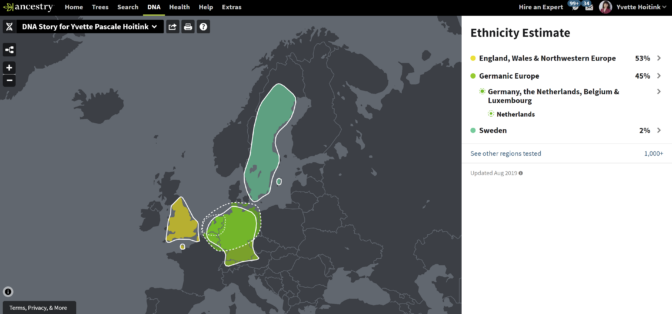
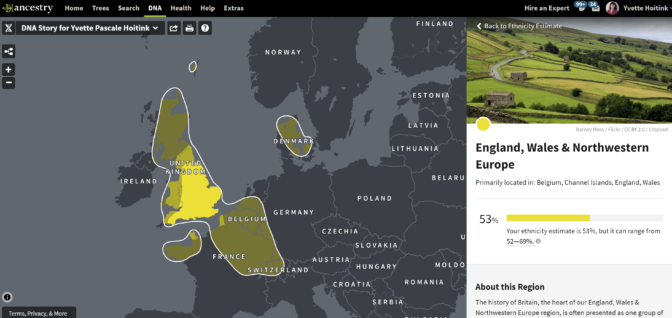
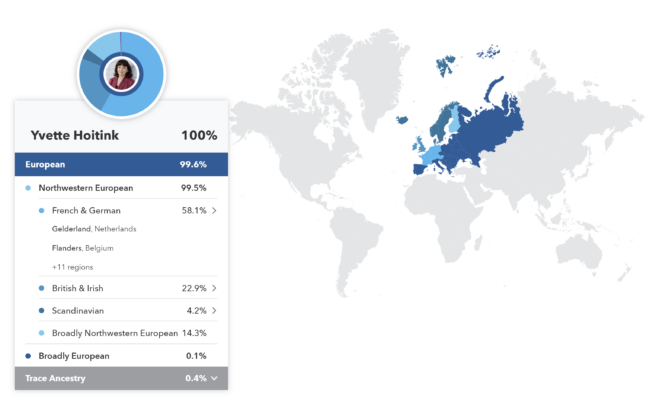
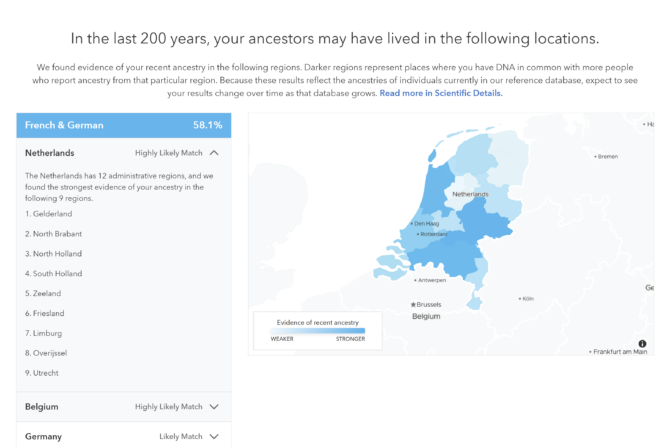
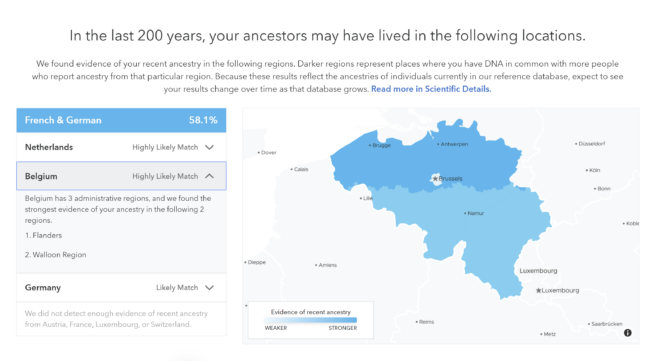
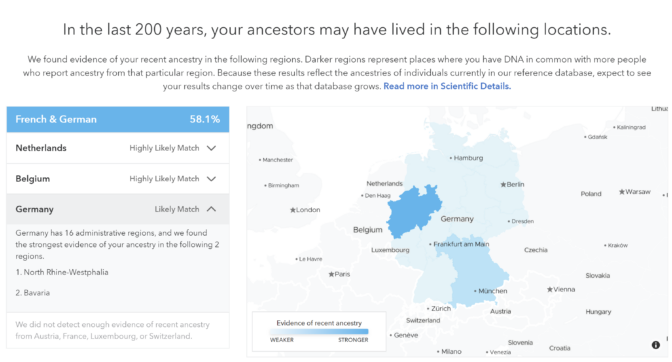
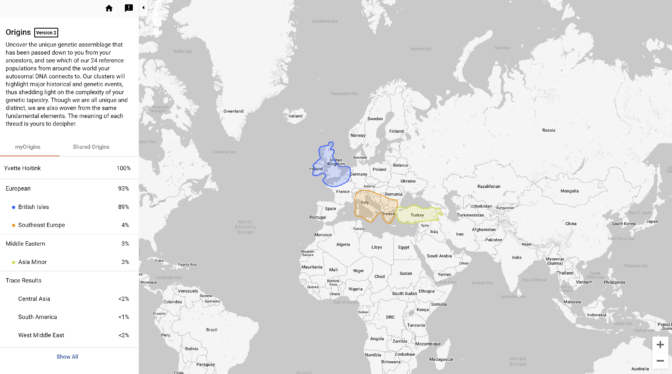
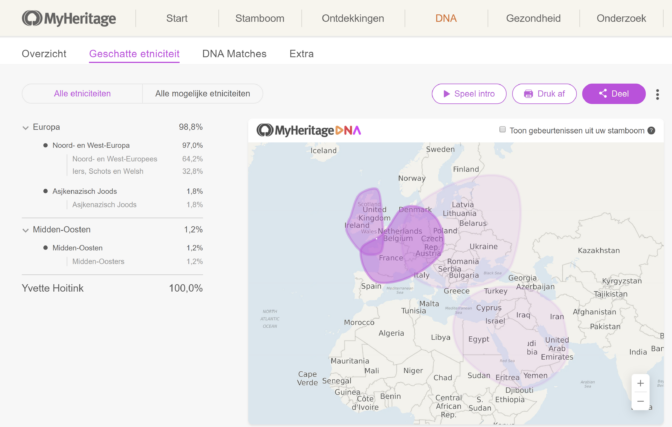
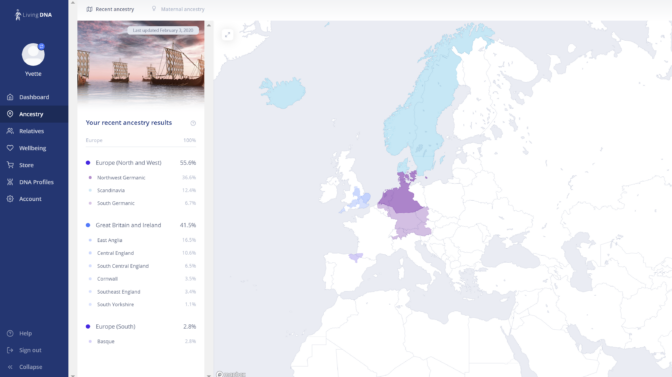


Hello, Yvonne. Thanks for sharing this. My grandparents all lived in Groningen for centuries before coming to the U.S. My earliest Ancestry results showed me firmly rooted in northern Netherlands, Norway, and Sweden. I am confused that more recent analysis shows a connection with the British Isles. It seems tribes and Vikings traveled south to Netherlands and Britain, carrying DNA and accounting for the same genes among the people. Am I wrong about that?
Old Frisian and Old English are very similar. Too much emphasis has been placed on Anglo-Saxon migration to England and too little on Frisian sea-faring merchants.
You might enjoy reading The Edge of the World by Michael Bye.
Oh, I am reading that now! It is a wonderful history with information I have not seen until now. There is so little Frisian history and even less, translated into English. Check out the FRISIA COAST TRAIL Blog – LOADS of info there too and you can sign up for alerts when a new article is posted.
I too have DNA matches in the UK. It seems that we are NOT English but that they are Frisian. Many of the “Viking” bones uncovered in the UK have shown Frisian DNA, not Norse. But, then again not all Norse were Vikings and not all Vikings were Norse!
This is fascinating – thanks for sharing your analysis, Yvette! I’m tempted now to test (and have my parents test) with 23andMe, to compare with their results from the other companies.
Are data available on the U.S. which would show Dutch genomic content which could be matched to provinces in the Netherlands?
From what I understand, the Netherlands were under Spanish rule for quite some time and many modern day Dutch have Spanish ancestry (I believe I’ve read one out of five, at least? but I can’t remember the exact statistic). Perhaps the Middle Eastern & Jewish could be remnants of that era of rule — possibly a Spanish-Dutch ancestor with strong/mostly Middle Eastern/Jewish heritage?
After 1492, when Sephardi Jews were expelled from Spain, Amsterdam became a Sephardi cultural hub. Many Sephardi intermarried, hence there are non Jewish Dutch with Jewish ancestry. There are a small amount of Dutch males (who have been sampled) who have the Y-Haplogroup r1a-z93, and this can be traced back to Ashkenazi Levite ancestry.
Thanks for your interesting comments. I have tested with Ancestry, FTDNA, My Heritage and Living DNA. Broadly speaking my experience matches yours. Some of Ancestry is spot on with what I know, others pretty vague. FTDNA I have found the least accurate. Most of Living DNA matches with what I know (but not all). My Heritage OK but pretty vague. It seems Sweden is pretty common – Although I don’t know anyone from there. Thanks, Neil
Earlier this year I took a test with Ancestry which gave a result of 84% England, Wales & N.W. Europe and 3% France. Since my mother and grandmother were both born in France (which I have evidence to prove this), I decided to take another test with My Heritage that gave a result of 76.8% North and Western European!
I have sent four e-mails to Ancestry and finally spending over an hour on a telephone call to the company querying their results. All to no avail. I suggested they refund me the fee or else provide another test kit free of charge.
In view of my experience, I would not recommend anyone to waste their money on taking a test. For a company of their standing I am staggered at the response I received to my complaint.
But the French are not a separate homogeneous genetic group.They are primarily a mix of Celtic and Germanic origin with some Roman influences particularly in the south of France.
And since most French migrants to the new world came from northern France they would have more Germanic DNA than people from southern France, after all Normandy is called Normandy because this was an enclave of Norman (Norwegian) settlers.
There is really very little genetic difference between French, British, German and Dutch DNA. So these results you got back are reasonable correct.
The Germanic people also inhabit northern Europe, therefor you can expect Scandinavia in your DNA map even if you come from northern France.
The modern nation states are a relatively recent invention, countries borders are artificial and the official languages of these nation states are in reality a local language or dialect that at a certain time during the birth of those nation states were chosen as the official language by those in power and forced upon the locals.
For example Dunkirk in France originally was called Duinkerken and Lille was called Rijssel because they spoke a Germanic language but now these same people speak French.
Thus there is no such thing as pure Dutch, British or French DNA, they are all more or less the same people who through historic events speak a different language and have adopted a different national identity, this makes the last devastating European wars just the more insane, and explains why the Europeans have decided to create the European Union
That is a great comment. Indeed countries did change names and borders. Some don’t exist. And with wars and persecution it cannot be that there is no mixture of DNA. Ofcourse the results will change as more people will enter in the database. A friend of mine did his DNA. He’s from German and Middle Eastern descent. The results show him having 40% Hispanic ( Spanish, Portuguese), Lithuanian, Russian, 1% Peruvian (!) and 0,5% Asian. No Middle Eastern at all.
Autosomal DNA represents where populations cluster, as opposed to where an individual’s relatives were born.
Living DNA use PCA charts to determine results. Their regions are the most accurate when it comes to autosomal clusters. Dutch people cluster close to southeast English, hence they may get results that suggest they are English. Their results have become much better since their 2020 updates, as they have added new regions, which means they no longer overestimate their British results.
Given that you are Dutch, it doesn’t surprise me that you score Northwest Germanic and English, as PCA charts show that this is where Dutch cluster. These results don’t make you any less Dutch. They just tell you that you cluster, primarily, with East English, Dutch, and northwest Germans.
I am Eastern European yet I score higher Southern European and Near Eastern results, than Eastern European ones, as my ethnicity is Ashkenazi. Ashkenazi Jews may be from countries like Poland, and Ukraine, yet on an autosomal level they do not cluster with East Europeans.
Very interesting article. Thank you. I always work on the assumption that I do not have a caste iron understanding of my ancestors although i have been researching them for 7 years. For example there is no guarantee that a fathers name on a birth certificate is correct. Further I have no knowledge of a Scandinavian ancestor but get many distant matches from there on both Living DNA and Familytree DNA.
I just found this article through a search for ‘Dutch ancestry test’ or something like that. I was curious to know how the ancestry tests classify the Dutch, as I just discovered that the branch of my family who lived in North America the longest was Dutch. 23AndMe failed to recognize any Dutch or Belgian ancestry for me though.
Like you, my husband with Frisian parents had quite a bit of British DNA. Myself, I’m from a British background and had some western European DNA. Both of us were surprised, but the more research I
do on the history, the more I am not surprised.
Flemish weavers were in high demand in England and Scotland. Huguenots fled western Europe for Scotland and England, and the Netherlands was Scotlands greatest trade partner at one time. Both countries also fished the same waters and met on the northern islands (exchanging knitting patterns amongst themselves and with Scandinavians as well)
I read in a book that at one point one of the little NE Scotland fishing villages had so many Dutch coins in the church collection they had to put a stop to it.
I know people are intensely proud of a certain heritage, but we have to open our eyes up to the fact that the sea ways were the mode of transportation and these people did travel.
Of course results also depend on the people who test. If more British people than Dutch people are using a particular testing site, then that is going to skew results as well.
Hi there,
Well I’m perplexed. I’m half English (mother), half French and my dan comes out as 56% southern Germanic, around 28% British and the rest from Iberia (south east). Now can anyone explain?
Hi Yvette, Thank you for your very informative article about DNA results over time and across various providers. I have been building my family tree for 10 years and have around 500 names dating back to the 1600’s and earlier. My parents and their ancestors were from Amsterdam/Haarlem and Groningen with traces back to Italy (Meinardi). I recently received my DNA results from MyHeritage and discovered I am 77.9% English, 17.1% Scandinavian, 4.2% Finnish and 0.8% Middle Eastern. No reference to Western Europe. It looked like an error until I read your article and saw the huge range of results. I may request another DNA test with another company.
The modern countries of today have not been closed off territories breeding an unique gnome type through the centuries. And DNA testing companies base their findings on their DNA data base gathered from different but limited locations. For example farmers entered Europe thousands of years ago from the near east and over time were more numerous than the original hunter gatherers. Hence all Europeans have near eastern DNA. These DNA testing companies look in their data base and see similar DNA traces among Jewish people, and since Jews also lived in Europe they will say that you have Jewish DNA traces when in actual fact these near eastern DNA traces go back to the farmers coming into Europe and having been passed on by all Europeans since. Further more both Celts and Germanic people have lived side by side in the Netherlands. It can even be argued that the Dutch language is a Germanic language with a Celtic pronunciation as the Dutch ch is pronounced like a hard g just like the Celtic ch is, and this is not found in other Germanic languages other than Dutch and the Celtic languages. And like the Britons are also a mixture of Celtic and Germanic origin, Dutch and Briton DNA is very similar.
In fact many of these companies are mainly USA based. And their original database is build by American DNA and labelled according to what these people filled in as their ancestry. And this is also a problem since there was a time in US history that the French speaking Cajun were looked down upon. Thus people of Cajun origin in that time would invent a different origin. Whilst being of Irish or German origin is very popular in our white American identity.
This has resulted in people filling in an imagined origin during the census, sometimes deliberate but mostly thinking that this was really so. And family names do not help, as difficult non English names used to be Americanized in the not so long ago past by public officials. With the result on one hand of Americans being very surprised to find out that they are of (for example) French rather than Irish origin, what they had always build their identity around including membership of the local Irish club etc. And on the other hand a database of DNA identification that is not correct.
But as more Europeans are sending in their DNA to these companies they will become more accurate in time, but for now I would not take their results to serious.
I know – its December – and I am finally scrolling through the e-mails I’ve saved and happened upon this one!
I CAN EXPLAIN THE BRITISH CONNECTION. We happened to see a random Documentary on TV last year. (I’ve tried to find the name of it – closest I can come is “Vikings – The Real Warriors” — but not sure) The Dutch are NOT British BUT – THE British ARE DUTCH! In doing DNA tests on bones found in ancient graves, in the UK, they thought they would find Norse/Viking. NOPE. They found FRISIAN!
My father’s National Geographic DNA test came back with the same similar findings as everyone here is talking about. He was stunned – “I’m NOT English!” he declared!” Then, mine came back with the same numbers. A friend called me to say – “You HAVE to watch this TV show!”
The DNA results match you with other similar matches – THUS, we have more matches in the UK than anywhere else so it LOOKS like we’re English but we’re not. They probably wonder why they’re DNA isn’t showing up English but has more matches in The Netherlands.
If I can find the name of that UK Documentary – I will post it here!!
So, these DNA tests don’t really tell you that you’re from a specific geographical area – they tell you that Your DNA MATCHES the most people from an area…..
I did find this reference to English/Frisian DNA
“Primary Frisian Y-DNA haplogroup is the R1b subclade called U106/S21, defined by its mutations U106 (and L48) and negative for P312. It’s coded by Family Tree DNA as haplogroup R1b1b2a1a. Its subclades include R1a1b1b2a1a1, R1a1b1b2a1a2, R1a1b1b2a1a3, and R1a1b1b2a1a4.
U106 is also found among partial descendants of Frisians like English people, as well as in parts of Benelux, Germany, and Denmark. ”
Came from this article – http://www.khazaria.com/genetics/frisians.html
“Frisian Genetics: Abstracts and Summaries”
by Kevin Alan Brook
I tested only with Living DNA in 2018, trying to prove a family tradition that one ancestor must have been from Central or Eastern Europe, although so far my ancestry is all French. At that time, I found their mapping of my haplogroup to be darker in Central Europe. It was a map in different shades of pink, with a list of different regions showing the percentage of my haplogroup found in each, in decreasing order. I found this presentation far more accurate than ethnicity by percentage. Did you get that map when you tested with them ? Was it accurate in your case ?
Well, my search for answers on things Dutch has once again led me back to Yvette!
I have not had my DNA tested, but my sister has, by Ancestry. Our mother is 100% Dutch whose ancestors settled along the shore in eastern Wisconsin – 7/8 of her line comes from the Winterswijk/Aalten area going back hundreds of years, and 1/8 came from Zeeland (having moved there from Belgium sometime in the 18th century.) I had figured that genetically we would look Germanic, but my sister only came in at 7%. She shows up as 2% Swedish. Most of her heritage on our mom’s side must fall into the chunk marked “English and Northwestern Europe,” but the thing that intrigued me is that she clocks in at 17% Scottish. A little of this might be attributed to our father’s side (the rest of his contribution to my sister’s DNA is very clear), but even if she hit the equivalent of the genetic lottery in soaking up every possible Scottish gene from dad, this could at most come to 7% (and more likely 4%), leaving 10% to come from mom. Statistically this would mean that we would expect our mother to have looked 20% Scottish to Ancestry’s algorithms! (I will add here that, due to family resemblances, we can vouch for the honesty of reports on paternity relationships this side of the ocean. One would imagine that the rural area around Winterswijk did not offer a lot of opportunity for illicit affairs with Scotchmen in the early 19th century, but what do I know?)
I’m curious if others from the Winterswijk/Aalten area have DNA that looks Scottish to Ancestry. Interestingly, and perhaps tellingly, reddish hair does run in part of our Dutch family.
Hi!
I’ve only been tested in MyHeritage and FamilyTreeDNA. I think both companies gave me similar results. They both knew that I’m a Spaniard, and I scored high in Iberian. FamilyTreeDNA even got my basque part, which I know to be true according to my family history ? MyHeritage doesn’t test the Basques apart, they include them in an umbrella category Iberian. My Iberian is, indeed, higher in MyHeritage because of this. They both gave me a small Italian percentage (3% in FamilyTreeDNA and 4% in MyHeritage, very similar). My maternal grandfather had relatives in Italy, so I guess this is also correct. They gave different results for the rest of my DNA. According to MyHeritage I am Scandinavian and Finnish. On my father side I have distant ancestors that came from Central Europe and I was expecting to have Northwest Europe because of that. My grandma used to say that her great grandparents (not all of them) were from “Germany or nearby”. She was from a place in Jaén that was inhabited by people from Central Europe who founded some villages there. She used to say it with all her Andalusian accent and she was so funny and lovely by expressing herself like that. “Alemania o por ahí” xd. I thought my Scandinavian and Finnish could come from these ancestors. Finally, new genetic groups gave me one that was “North Holland, South Holland, Utrecht and Gelderland”. So I guess they weren’t Germans after all. I got an Italian genetic group that matches with my maternal grandfather’s family.
FamilyTreeDNA gave me similar but different results at the same time. According to this company I’m 10% British, Scottish and Welsh and 3% Northwest European. I read in the very same MyHeritage that British is one of the most common ethnicities for my genetic group, along with Northwest Europe and Scandinavian.
I suppose it’s hard for companies to be totally accurate but in my case I think they got me and my ancestry quite well ?
Hi Yvette,
My mother was exactly half Irish and almost half Dutch with a little English/Irish mixed in. Her mother’s paternal side was from Friesland originally and settled in colonial New York (Amsterdam) in the 1600s. In the early 1800s they married into mostly English Families. My father’s side are Southerners with mostly English, Scots and Scots-Irish, and a tiny bit of Native and African. My Y-DNA is consistent with a Welsh origin, so there’s that. I came up as Mostly British and Irish in 23 and Me, with the majority Irish and rest English/Scottish/Norther Irish. They only give me about 1-2% Broadly NW Europe, Swedish and Finnish, and less than 2% Native and African. Ancestry gives me 27% Irish, 26% Scottish, 24% British and Northern Europe,7% Wales, 7% Germanic, %5, 3% and 1% Sweden, Norway and Finland respectively. Family Tree is the most off with 82% Irish, 3% Central Europe,
I’m guessing the Scandinavian may come from Denmark if my ancestors were from the Northern Friesland area. Ancestry seems to be the closest, except for leaving out the Native American and African.
Thank you for the article. Informative, but not in the way I was hoping.
Which companies provide the best genealogical experience. Ethnic make-up reports are a gimmick. What is actually important is which of the companies do the best job at allowing you to confirm Dutch relationships you’ve hypothesized from the public records, or to open up dead ends (e.g. an unwed mother).
Do you have any insight into those kinds of questions?
Yes, see this article: https://www.dutchgenealogy.nl/dutch-dna-testing-strategy/
Very interesting article. I too have an ancestral connection to Westphalia (Osnabruck area) via my maternal Grandfather’s paternal line (M405/U106->Z18), although having difficulty in determining how they ended up there. The melting pot that is Western/Central/Eastern Europe seems to really complicate things for me. The surname is Brackmann, which I believe is most probably a place conjugated name related to a migration from near a coastal region. I believe they moved to Westphalia sometime in the late 1500’s. I have a couple of theories (listed in order of thought probability) based on population movement patterns for the surname in question:
1) Netherlands migration.
2) Jutland/Coastal Baltic Sea migration.
3) Bavaria migration.
Curious if you have any thoughts on direction for this.
My relatives are from a village in Sicily. Genetic Scientists describe it as ‘genetically isolated’. The test results are unable to place my cousins on Sicily, at all. When I look at the ‘where from’ predictions they are all Northern European. The Y DNA has no path from Hungary to Albania, lots of results available otherwise. The mtDNA also lacks a migration pattern leading to Sicily.
My great grandparents returned to the USA in 1919. When again entering the USA they wrote there were no immediate relatives left. They had gone back in 1913 and got stuck on Sicily for the First World War. In 1919 they were 72 and 80 years old.
The surname appears to remain in only 4 Sicilian villages. Here in the USA there has been intermarriage with people having different geographies. Such that the DNA tag that says your from here or there has steep competition to be noticed when selecting a particular ‘lifetime of years’ from the timeline of DNA.
My Sicilian grandmother has a piece of DNA that also belongs in Vietnamese ancient history (before there was a Vietnam) Grandmother was Sicilian since time began as far back as the records of Sicilians from tiny villages. So it seems, the testing company was forced to choose which side of the world to place my grandmother. It chose correctly because it knows she is Western due to the associated genes required to be Western and the lack of those to further support Asiatic geography.
I’m amazed what $100 buys.
Hi Yvette- I enjoyed reading your article. Family Tree DNA recently updated there ethnicity estimates and for myself it’s an improvement. I find MyHeritage extremely useful because of their International customer base DNA matches. I have not taken the 23 & Me test, but I’ve heard other customers say compared to their known family history and family tree, it is their favorite also. Ancestry DNA appears consumed with their clientele being mostly from the USA and I find their estimates further off the mark with each update. Living DNA even with their latest update is still by far the most perplexing inaccurate test results I’ve ever received. All in all, a good old fashion researched family tree still reigns best.
It will be interesting to see what your 2021 results are from Living DNA, because they have over corrected in regards to English, and Northern Europeans. People with English ancestry are now scoring about 5% South Germanic. You could possibly have far less English in your results.
I know someone who is half English who now only scores 19% British and Irish, at the expense of 22% French, and 5% South Germanic. I would understand an English person scoring Northwest Germanic, as Angles, and Saxons are Northwest Germans. While South Germanic people cluster close to English, they don’t cluster as close as Northwest Germanic people do. The French results probably represent Celtic DNA. It seems like the reverse is happening, and that is that English people are now scoring too high when it comes to Europe North and West. My friend is now complaining because they have no affinity with, or ancestry from Southern Germany. While they are not pro-British imperialist, they are honest about their English side, and can identify with English regions which they have lost to Southern Germany.
This person is half Ashkenazi Jewish, and their Ashkenazi results are far more accurate (southern European (Southern Italian, and a small Northern Italian percentage), and Near Eastern (South Caucasus, and Arabia). Several years ago they found their Ashkenazi results simplistic, but now they are happy with them.
Living DNA used to be shocking when it came to Ashkenazi results, but now I think they are good. My personal results are consistent with other Ashkenazi results. They are not that good when it comes to English and North European people, as they confuse the two. Perhaps Living DNA should just have a Teutonic category that covers England, Germany, the Netherlands, and northern Belgium. and then all the Northwest Europeans would be happy.
Interesting I got onto a Dutch family tree website called Ponds nl
to study my father’s family looking back Two hundred years his family surnames are Dutch with one branch Frisian and one surname was French.
Ancestry DNA has me at 8% Scandinavian, but my tree has zero ancestors to back that up. I have many from the Netherlands and Great Britain though, I guess that’s a close call. It’s interesting that some of your relatives got a similar Scandinavian estimate with no real basis. I was beginning to think adultery was involved, or Vikings; I was puzzled. But it’s probably just their Scandinavian algorithms are not quite up to par.
Ancestry got closer with my other European ancestry, within 10% +/- of reality. They completely missed ethnicities where I only have a few ancestral trees- Native American, French and Italian were left out of the DNA results for instance. These tests, and I’ve taken a few too, they are like a fun parlor game. The real interesting stuff is in the trees and documentation there!
This is very interesting. I grew up in the United States with windmills and wooden shoes all around the house. We were proudly American, but proudly Dutch as well. When I got my results from Ancestry.com, I wondered, “Where’s the Dutch?”, but it’s all beginning to make sense now due to the research I’ve done, which includes finding your story. Thanks for posting your research.
I am of the Mennonite heritage from the United States, and both of my parents came from Prussian Mennonites of Dutch heritage. The Mennonites are endogamous and did not intermarry much. The vast majority of my DNA should point to the Netherlands as an origin. However, Family Tree DNA estimated my ethnicity as 42% England, Scotland and Wales, and 37% Central European (Includes Germany, France, etc.) and 10% West Slavic. I think that there probably is some Polish in there from several centuries of living there. But the British Isles doesn’t make sense. We have good genealogical records, and it seems that all of the families came over from the Low Countries. They don’t seem to be able to distinguish Dutch DNA from British.
What that shows is that your DNA MATCHES more people in the UK than anywhere else. The Dutch & Frisians were a large presence in the UK as you go back in time. My father’s and my own DNA show the same thing, even though we have an extensive family tree that shows Netherlands heritage. Take heart – You are NOT English – They ARE Dutch!
Yvette, Thanks for this. It’s truly fascinating. I just got my results from ancestryDNA and while my last name is Huizenga and I have relatives from Huizinge Groningen, Netherlands back to 1650, that side of my heritage is listed as Norwegian (I’m assuming this since my Dad’s father was Dutch and my Dad’s mother was Swedish). I was listed as 26% Swedish, 23% Norwegian and 1% England and Northwestern Europe. I was super surprised that there was no Dutch ancestry. I’m going to test my Dad as well. Do you have any insight on this?
Thanks!